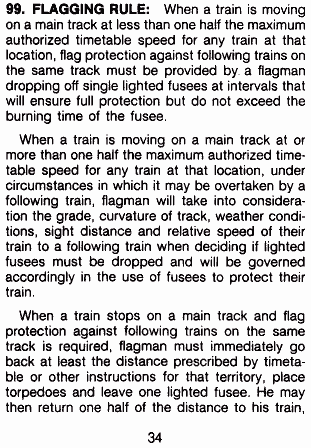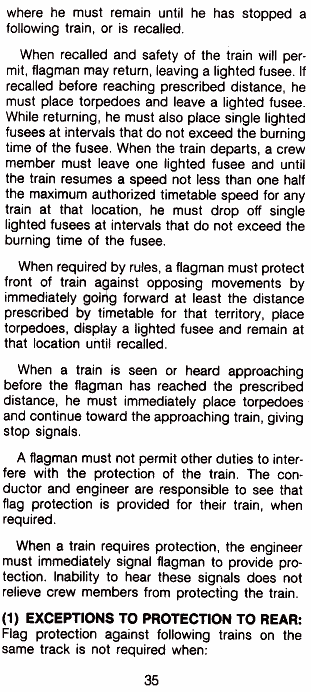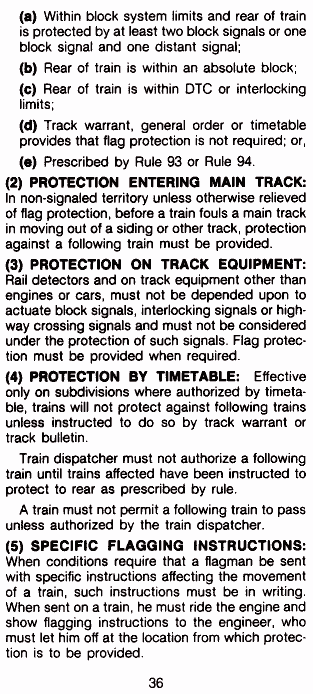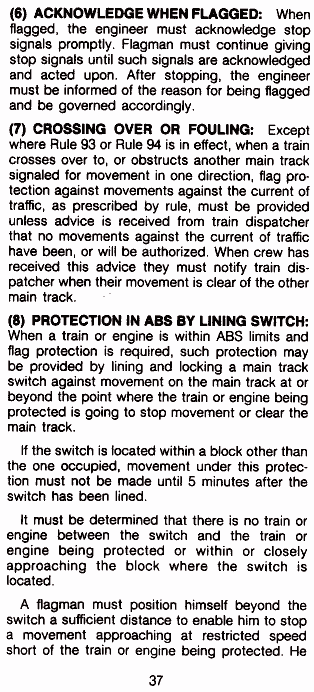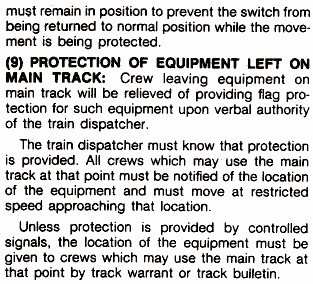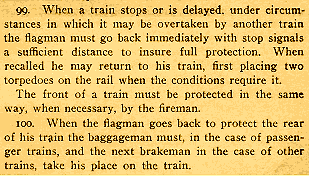Rule 99: the Flagging Rule
Ignore it and your deodorant will not provide adequate personal protection...
Ignore it and your deodorant will not provide adequate personal protection...
In the primeval days of railroading, Rule 99 - train crew protection from other trains - was practiced somewhat casually, but as train speeds increased (particularly after the introduction of air brakes) collisions became more horrendous, and flag protection became a matter of grave concern.
Rule 99 reflected this, it requirements gradually growing ever more complex over the years. Correspondingly, as time progressed, flagmen were required to deploy ever greater distances from their trains.
Since this subject is probably primarily of interest to the professional railroader, and then probably only to the subcategory of 'rules instructor', we are going to forgo most explanation here. For you laymen, to understand how flag protection generally works, you might first read the 1989 rendition of the General Code of Operating Rules, which is reproduced at page bottom.
The Long and the Sort of It: 1901 vs. 1983
The evolution of Rule 99 from a simple 'use your head' requirement to a highly structured set of rules can be seen by comparing the 1900 Wheeling & Lake Erie version with the 1983 Southern Pacific offering. Notable is the term 'sufficient distance', which is unspecified in the 1900 rule. The 1983 rule went on at some length in defining the term, but still did not specify the exact minimum. SP's rule-of-thumb was a minimum of one mile for 25 mph-or-less territory, and two miles otherwise. Exact requirements for a particular subdivision typically could either be found in the Timetable Special Instructions, or in a Superintendent's Special Notice. Of course, if you flagged back 1.25 miles on 20 mph track, and the train behind you lost its air and piled into your caboose, you still had an excellent chance of being fired: you should have known that, just before seeing you, the following engineer would be releasing his air because he had too much in them to balance the grade.
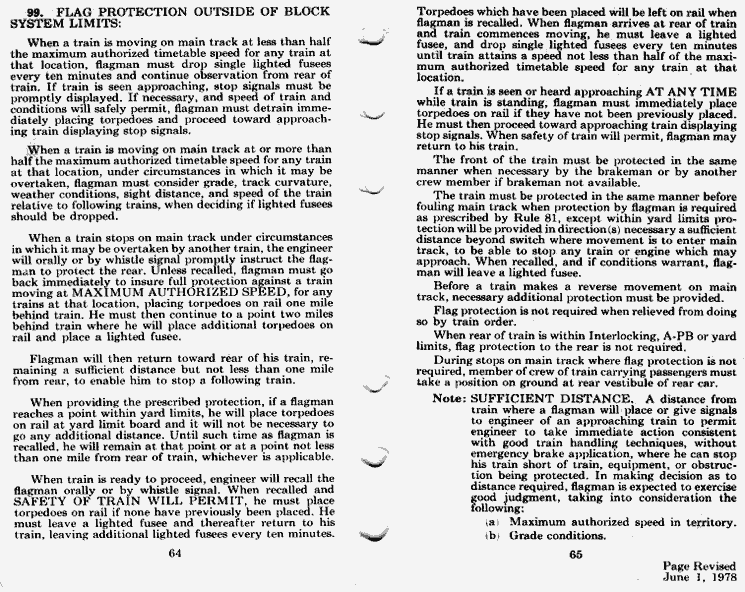
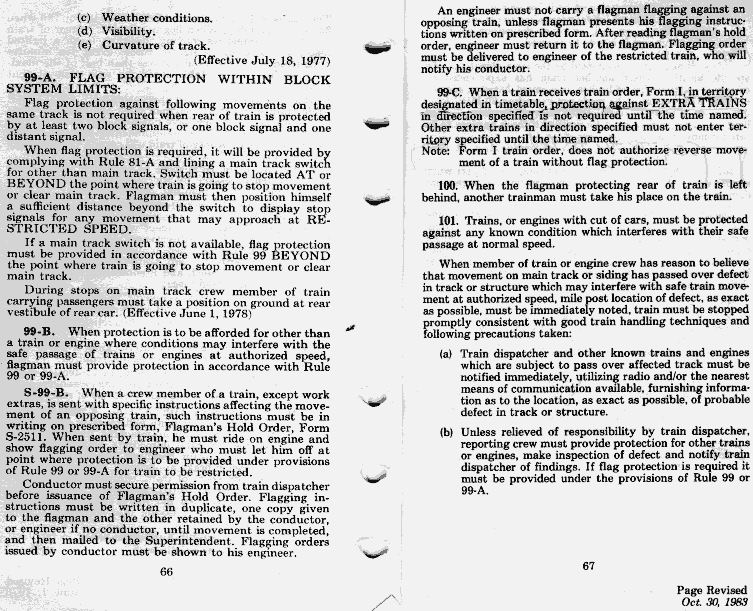
Faster Trains Mean a Longer Walk
Although the above rule books don't specify an exact distance, Southern Pacific's once did. In comparing SP's 1930 and 1942 rule books, we see an increase in flagging distances in proportion to a general increase in train speeds. It's interesting that train speeds increased during the Depression, a time when few railroads had extra cash to devote to the associated costs of increasing speed. But this was the beginning of the streamliner era, a time when railroads grew more competitive with each other for the share of the dwindling pie. In 1930, few U.S. passenger trains ran faster than 60 m.p.h., whereas by World war II many railroads ran their streamliners above the century mark. Little noticed by historians is the fact that freight train speeds rose as well. Steel wheels, AB brakes, faster engines, and a gradual move away from the 'drag the yards' philosophy all helped to make 40 m.p.h. freights common.
SP, 1930
SP, 1942

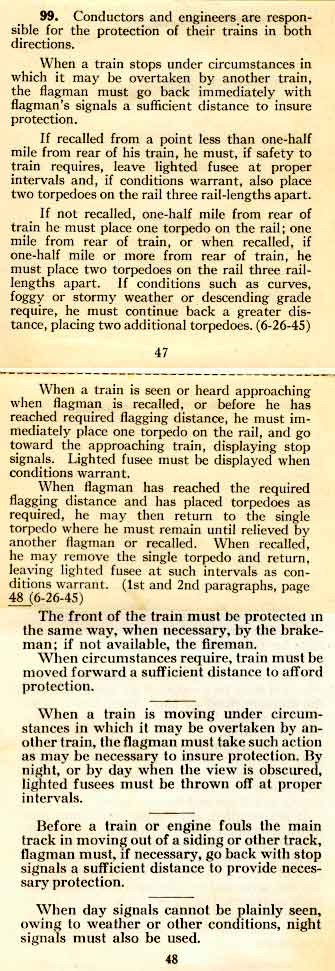
Though SP eventually regarded flagging to the rear in block signal territory as redundant, one portion remained until the late 1970's - when stopped, a passenger train flagman was required to take up a position 30 feet behind the tail car.
The relinquishing of the rear end requirements did not change those on the head end, however, since block signals only are designed to protect against following movements. The only notable change in head end flagging requirements was in an associated rule - how trains would progress after stopping for a Stop and Proceed signal. Until 1980, or so, SP required a flagman to walk ahead of the train all of the way to the next signal. After that, the flagman was eliminated in favor of a beefed-up version of the Restricted Speed rule.
Incidentally, did you notice the pasted overlays on the above pages? Until SP's Rule Book became loose leaf in the mid-1970's, changes required pasting into the hardbound 'Black Book'.
The General Code, 1987:
The Standard That the Individual Subscribing Railroads Feel Compelled to Modify
The Standard That the Individual Subscribing Railroads Feel Compelled to Modify
As already noted, the 1987 Code includes a very extensive amount of instructions about flagging specifics, something useful to the lay person who is somewhat unclear on the general concepts.
